梅特勒托利多TGA SDTA851热重分析仪操作手册
- 格式:pdf
- 大小:2.11 MB
- 文档页数:67

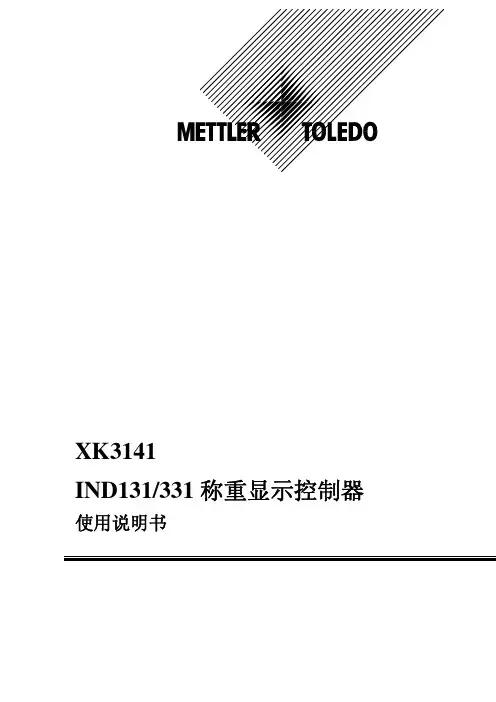
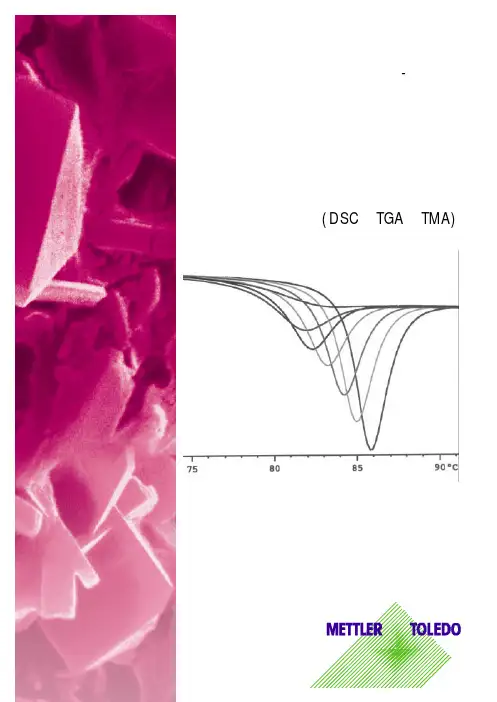
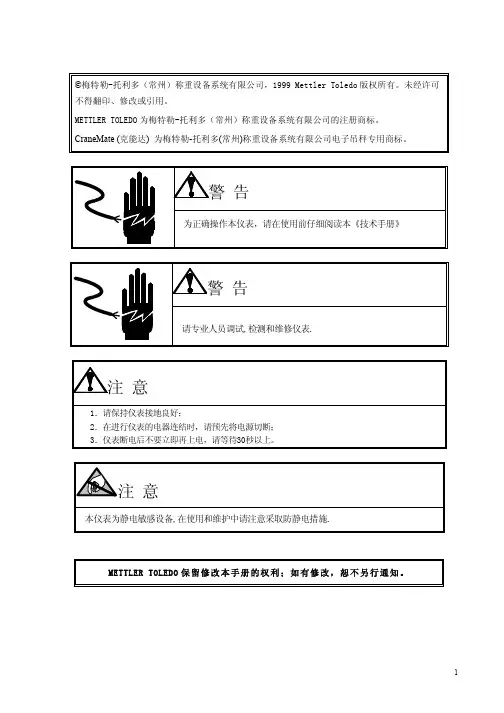
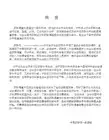
METTLER TOLEDO STAR e系统TGA/SDTA851e热重分析仪操作说明书目录1前言和安全注意事项 (1)2TGA/SDTA851e仪器 (9)3恒温浴槽 (21)4 安装 (26)5开启和关闭 (30)6称量 (32)7测量 (42)8校准 (48)9维护 (50)10出错信息、警告和故障 (61)TGA/SDTA851e 1 - 前言和安全注意事项1前言和安全注意事项1.1STAR e系统中的TGA/SDTA851e热重分析仪STAR e系统欢迎进入梅特勒-托利多的STAR e系统。
STAR e系统包括STAR e软件和以下主机:DSC822e,HPDSC827e,TGA/SDTA851e,TMA/SDTA840和DMA/SDTA861e。
在本操作说明中,TGA/SDTA851e热重分析仪简称为TGA/SDTA851e。
STAR e系统在进行第一次测量前,请仔细阅读本章的安全注意事项。
警告TGA/SDTA851e仪器是一台在进行热重分析(TGA)的同时,能同步进行差热分析(SDTA)的先进仪器。
进行热重分析时,我们可以测得在设定的温度程序下,一定的气体气氛中样品的质量变化。
热重分析而进行同步差热分析时,我们可以得到在设定的温度程序下,一定的气体气氛中样品的温度相对于参比温度的变化。
不同的TGA/SDTA851e型号在操作时需要的软件版本也有所不同,如下所示:TGA/SDTA851e/ SF/1100℃TGA/SDTA851e/LF/1100℃TGA/SDTA851e/LF/1600℃STAR e软件版本≥3.1 版本≥4.0 版本≥5.1Module软件版本≥4.0 版本≥4.0 版本≥4.1*更多关于STAR e软件的说明,请参阅STAR e软件操作说明书。
差热分析1 –前言和安全注意事项TGA/SDTA851e1.2 选配件对于TGA/SDTA851e仪器,有如下的选配件:•TSO801RO自动进样器•TSO800GC或TSO800GC1气体控制器•TGA-MS转换工具包,TGA-FTIR接口•开关线闸*在测量前对坩埚进行自动打孔的工具包已经包含在自动进样器中。
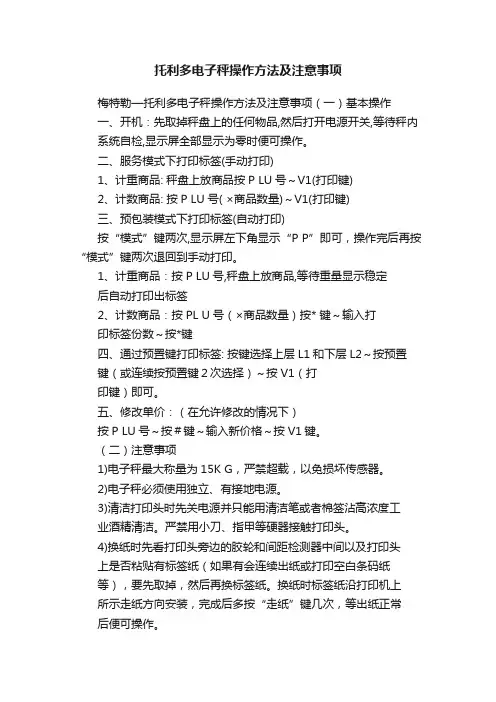
托利多电子秤操作方法及注意事项梅特勒—托利多电子秤操作方法及注意事项(一)基本操作一、开机:先取掉秤盘上的任何物品,然后打开电源开关,等待秤内系统自检,显示屏全部显示为零时便可操作。
二、服务模式下打印标签(手动打印)1、计重商品: 秤盘上放商品按P LU号~V1(打印键)2、计数商品: 按P LU号( ×商品数量)~V1(打印键)三、预包装模式下打印标签(自动打印)按“模式”键两次,显示屏左下角显示“P P”即可,操作完后再按“模式”键两次退回到手动打印。
1、计重商品:按P LU号,秤盘上放商品,等待重量显示稳定后自动打印出标签2、计数商品:按PL U号(×商品数量)按* 键~输入打印标签份数~按*键四、通过预置键打印标签: 按键选择上层L1和下层L2~按预置键(或连续按预置键2次选择)~按V1(打印键)即可。
五、修改单价:(在允许修改的情况下)按P LU号~按#键~输入新价格~按V1键。
(二)注意事项1)电子秤最大称量为15K G,严禁超载,以免损坏传感器。
2)电子秤必须使用独立、有接地电源。
3)清洁打印头时先关电源并只能用清洁笔或者棉签沾高浓度工业酒精清洁。
严禁用小刀、指甲等硬器接触打印头。
4)换纸时先看打印头旁边的胶轮和间距检测器中间以及打印头上是否粘贴有标签纸(如果有会连续出纸或打印空白条码纸等),要先取掉,然后再换标签纸。
换纸时标签纸沿打印机上所示走纸方向安装,完成后多按“走纸”键几次,等出纸正常后便可操作。
5)输入P LU号和操作错误时按“清除”键清除。
秤盘上无商品显示屏重量位显示为正负数时按“清零”键清除。
6)键盘上的“代码”键和“模式”键严禁随意按动`,以免改变秤内参数致使电子秤不能正常使用。
7)按键盘上的按键请用指腹,严禁用指甲按键盘上的按键。
8)电子秤必须做好防水和防虫处理。
9)如发现问题,请及时与电脑员或本公司联系!托利多电子秤操作手册编制PLU:按“代码”——8*——02*——输入新PLU号——输入货号(条形码)——输入商品名称(查字表,每输4个字符后按空格键)——输入单价(公斤价)——输入保质天数(多少天)——输入计价方式(0:计重1:计数)—(输入完成并返回到下一个PLU),如果继续输入新商品,请接至前面“输入新PLU号”的位置开始,如果不输请按“代码”两次退出。
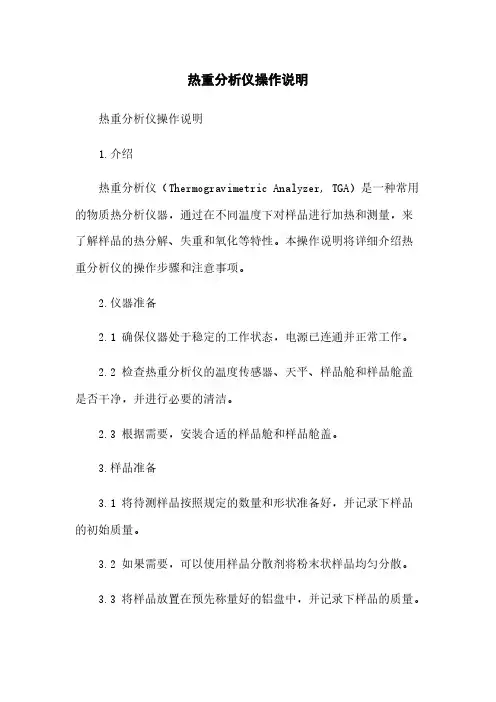
热重分析仪操作说明热重分析仪操作说明1.介绍热重分析仪(Thermogravimetric Analyzer, TGA)是一种常用的物质热分析仪器,通过在不同温度下对样品进行加热和测量,来了解样品的热分解、失重和氧化等特性。
本操作说明将详细介绍热重分析仪的操作步骤和注意事项。
2.仪器准备2.1 确保仪器处于稳定的工作状态,电源已连通并正常工作。
2.2 检查热重分析仪的温度传感器、天平、样品舱和样品舱盖是否干净,并进行必要的清洁。
2.3 根据需要,安装合适的样品舱和样品舱盖。
3.样品准备3.1 将待测样品按照规定的数量和形状准备好,并记录下样品的初始质量。
3.2 如果需要,可以使用样品分散剂将粉末状样品均匀分散。
3.3 将样品放置在预先称量好的铝盘中,并记录下样品的质量。
4.实验操作4.1 打开热重分析仪软件,进入操作界面。
4.2 设置实验参数,包括加热速率、温度范围、样品编号等。
4.3 将装有样品的铝盘放置在样品舱中,然后将样品舱盖盖好。
4.4 关闭样品舱门,确保完全密封。
4.5 开始实验,开始自动加热和测量过程。
4.6 实验过程中,可以实时查看样品的失重和温度变化情况。
4.7 实验完成后,保存实验数据并进行必要的分析。
5.安全注意事项5.1 在操作过程中,注意避免样品和样品舱盖的烫伤。
5.2 操作人员需要戴上适当的防护手套和眼镜,以防止误伤。
5.3 确保仪器的电源连接良好,并避免电源线受到过度拉伸或损坏。
本文档涉及附件:无。
本文所涉及的法律名词及注释:1.热重分析仪(Thermogravimetric Analyzer, TGA):一种用于测量样品在不同温度下质量变化的仪器。
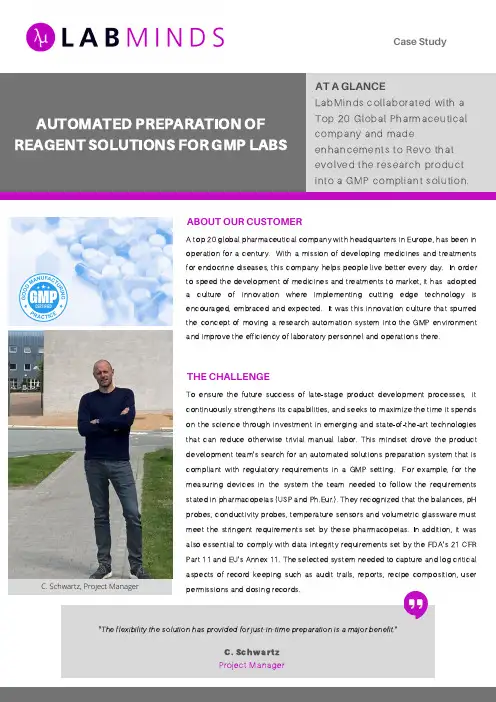
To ensure the future success of late -stage product development processes, itcontinuously strengthens its capabilities, and seeks to maximize the time it spendson the science through investment in emerging and state -of -the -art technologiesthat can reduce otherwise trivial manual labor. This mindset drove the productdevelopment team ’s search for an automated solutions preparation system that iscompliant with regulatory requirements in a GMP setting. For example, for themeasuring devices in the system the team needed to follow the requirementsstated in pharmacopeias (USP and Ph.Eur.). They recognized that the balances, pHprobes, conductivity probes, temperature sensors and volumetric glassware mustmeet the stringent requirements set by these pharmacopeias. In addition, it wasalso essential to comply with data integrity requirements set by the FDA ’s 21 CFRPart 11 and EU ’s Annex 11. The selected system needed to capture and log criticalaspects of record keeping such as audit trails, reports, recipe composition, userpermissions and dosing records.THE CHALLENGEA top 20 global pharmaceutical company with headquarters in Europe, has been inoperation for a century. With a mission of developing medicines and treatmentsfor endocrine diseases, this company helps people live better every day. In orderto speed the development of medicines and treatments to market, it has adopteda culture of innovation where implementing cutting edge technology isencouraged, embraced and expected. It was this innovation culture that spurredthe concept of moving a research automation system into the GMP environmentand improve the efficiency of laboratory personnel and operations there.ABOUT OUR CUSTOMER"The flexibility the solution has provided for just -in -time preparation is a major benefit."AUTOMATED PREPARATION OFREAGENT SOLUTIONS FOR GMP LABS Case StudyAT A GLANCEC. SchwartzProject ManagerLabMinds collaborated with aTop 20 Global Pharmaceutical company and madeenhancements to Revo thatevolved the research productinto a GMP compliant solution.C. Schwartz, Project ManagerTHE SOLUTIONAfter an extensive review of available solutions,they selected LabMinds® Revo®,the benchtop automated solution preparation system that enables companies to automate the reagent preparation bMinds,upon the customer’s request,decided to collaborate and make enhancements to Revo that would evolve the research product into a GMP compliant solution.The project was launched in May of2019and they set out to find a dedicated and innovative technical Project Manager to drive this project.Schwartz was assigned as Project Manager.Schwartz is a specialist in laboratory automation and has a strong track record of leading teams and driving transformation.He accepted the challenge in a large part due to the fact that he had previous exposure to the Revo system from the2016SLAS conference when Revo won the innovation award.He recognized the potential to transform Revo into a GMP compliant system and accepted the challenge.REAGENT SUPPLY SCENARIOSThe above graphic demonstrates the need and the options available for reagents in a lab.By using the Revo, just in time reagent solutions are achieved without using lab personnel time.FORMING A TEAMSchwartz formed a dedicated team comprised of subject matter experts including a chemistry specialist and cross functional experts from other departments.This team combined forces with LabMinds and worked to deliver an automated solution preparation system that complied with GMP requirements.They knew that it needed to deliver a solution that provided the consistent quality,traceability and documentation required in the regulated pharmaceutical industry.The team also sought to solve three main challenges: reducing the time lab technicians spent on preparing reagents to allow them to focus on the science; limiting solution overproduction; and eliminating risk associated with manual documentation processes.After 18 months of intense dedication, the team achieved a huge milestone and Revo was approved internally for use in its GMP laboratory. The system approval was earned through a series of rigorous data integrity process reviews and hardware upgrades. They were then able to tackle the challenges they set out to solve. Just a few months after the launch, the team on -boarded many of its recipes and is already seeing positive impact.SYSTEM APPROVAL“I appreciate the opportunity to work for a company that iswilling to implement cutting edge technology. We willreap many benefits moving forward,” commentedSchwartz, the Project Manager. “The flexibility the solutionhas provided for just -in -time preparation is a majorbenefit. We have already reduced solution overproduction costs and leveraged the Revo system toreallocate our reagent prep team from redundant tasks towork that helps increase the speed of productdevelopment.”"I appreciate the opportunity to work for a company that is willing to implement cutting edge technology that will reap many benefits moving forward."C. Schwartz Project ManagerPrior to the implementation of GMP Revo, three laboratory technicians spent an entire daypreparing reagents for the week. Upon review of recipes required, many were found tohave an organic component. To overcome a current system limitation, LabMindsdeveloped a workflow process where the Revo produces the aqueous portion of thesolution with instructions for the organic component addition printed on the label. Eventhough organic components are still added manually it was decided that the newfoundflexibility of automating the manual weighing, pH verification and data registration madethe process worthwhile. The system now allows the team to order the reagents via theWeb or mobile interface, and reduces the FTE time needed to fulfill monotonous,procedural laboratory tasks by 66%. This allows these key team members to focus on thedata analysis and scientific work needed to produce results from sample analysis.POSITIVE RESULTSThis lab technician team also used to ensure that they did not run out of reagents during the week by creating an extra supply. At expiry, extra solutions were thrown away. Now the team has implemented just -in -time inventory best practices and produce the exact quantities of the solutions they need. They know that they have increased flexibility, and if they need more solutions they do not have to stop analysis to create them. They can simply reorder via the easy Web interface, and the solution will be ready within an hour. This flexibility allows the team to reduce the amount of inventory needed each week.Prior to the implementation, the team manually tracked preparation data on paper to ensure they could obtain the necessary information for upcoming audits. Now, the team utilizes a QR code printed on the bottle label that contains all information describing the preparation and scans this data directly into the LIMS system where a record is created for each bottle.C. Schwartz and the Revo systemhttps:///labmindsinchttps:///labmindsinchttps:///company/labminds/“After 6 months in operation I get continued feedback from the users on how happy they are to be relieved from the tight planning of manual preparation they used to have. Even though organic components are still added manually it is by far overshadowed by the newfound flexibility in the fact that all manual weighing, pH verification and data registration are completely removed from the process.”C. SchwartzProject Manager© 2021 LabMinds. . All Rights Reserved. LabMinds and Revo are registered trademarks and the property of LabMinds.Unauthorized use is strictly prohibited.Scanning of QR code imports solutions data into LIMSCHALLENGESBENEFITS Reduce FTE time spent on preparing reagents Reagent prep FTE time decreased by 66%Limit solution waste Just -in -time inventory best practices reduced solutionoverproduction costsEliminate risk with manual documentationprocessesDocumentation completed with full transparency andregulatory compliance provides peace of mind All samples, solutions and controls are registered in the LIMS, and thisdata aligns with existing records to populate the documentation ofthe analysis and ensures audit readiness. This process not onlyreduces the chance of human error, but also frees up time for the labtechnicians to focus on other tasks. Our customer now has peace ofmind knowing that documentation is completed with fulltransparency and regulatory compliance.。
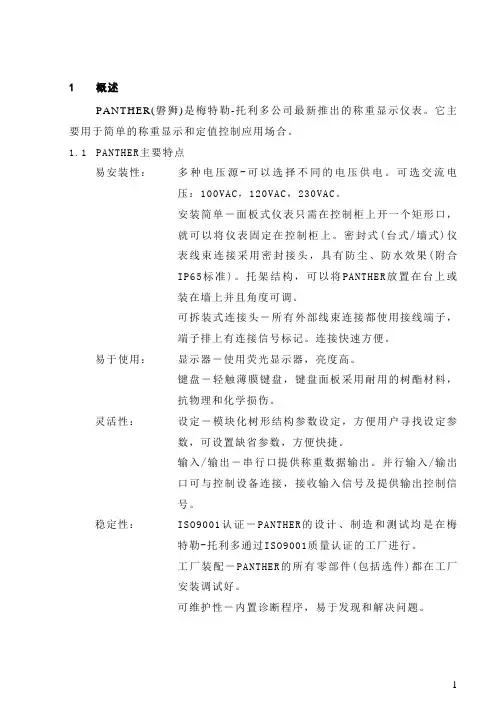
1 概述PANTHER(磐狮)是梅特勒-托利多公司最新推出的称重显示仪表。
它主要用于简单的称重显示和定值控制应用场合。
1.1 PANTHER主要特点易安装性:多种电压源-可以选择不同的电压供电。
可选交流电压:100VAC,120VAC,230VAC。
安装简单-面板式仪表只需在控制柜上开一个矩形口,就可以将仪表固定在控制柜上。
密封式(台式/墙式)仪表线束连接采用密封接头,具有防尘、防水效果(附合IP65标准)。
托架结构,可以将PANTHER放置在台上或装在墙上并且角度可调。
可拆装式连接头-所有外部线束连接都使用接线端子,端子排上有连接信号标记。
连接快速方便。
易于使用:显示器-使用荧光显示器,亮度高。
键盘-轻触薄膜键盘,键盘面板采用耐用的树酯材料,抗物理和化学损伤。
灵活性:设定-模块化树形结构参数设定,方便用户寻找设定参数,可设置缺省参数,方便快捷。
输入/输出-串行口提供称重数据输出。
并行输入/输出口可与控制设备连接,接收输入信号及提供输出控制信号。
稳定性:ISO9001认证-PANTHER的设计、制造和测试均是在梅特勒-托利多通过ISO9001质量认证的工厂进行。
工厂装配-PANTHER的所有零部件(包括选件)都在工厂安装调试好。
可维护性-内置诊断程序,易于发现和解决问题。
标准-PANTHER的设计符合有关国际计量和电气安全标准,以及电磁兼容性标准。
1.2 PANTHER技术特性PANTHER有两种型号:密封式(台/墙式)及面板式两种。
1.2.1 硬件特点•7位荧光段码显示器•6个轻触薄膜键盘•接线端子•一体化PCB板结构标准模拟传感器输入接口,可驱动8只350Ω的传感器双向串行口:COM1(RS232)并行口:一个输入,三个输出功能扩展口1.2.2 密封式外观特性•不锈钢外壳•外壳符合NEMA4X(IP65)标准•不锈钢支架•NEMA4X(IP65)密封接头•外部不用螺丝装配•五个LED指示灯指示OVER/UNDER分选或预置点状态1.2.3 面板式外观特性•铝合金拉伸外壳•不锈钢前面板•前面板符合NEMA4(IP65)标准•面板式安装•三个LED指示灯指示过量/正常/欠量,并可与预置点的输出状态对应。
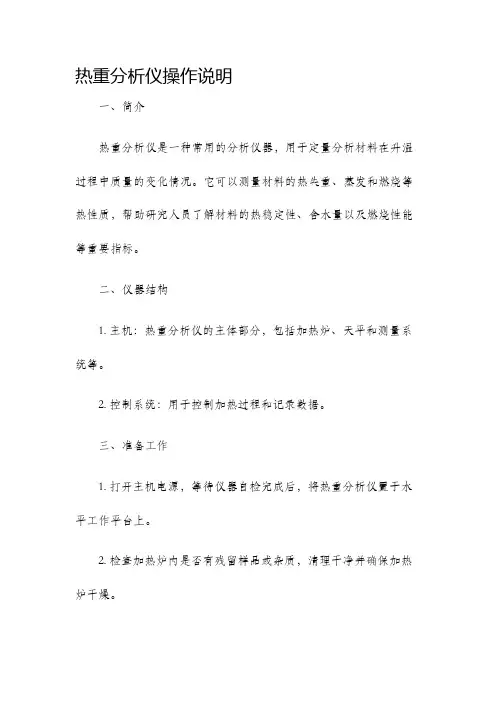
热重分析仪操作说明一、简介热重分析仪是一种常用的分析仪器,用于定量分析材料在升温过程中质量的变化情况。
它可以测量材料的热失重、蒸发和燃烧等热性质,帮助研究人员了解材料的热稳定性、含水量以及燃烧性能等重要指标。
二、仪器结构1. 主机:热重分析仪的主体部分,包括加热炉、天平和测量系统等。
2. 控制系统:用于控制加热过程和记录数据。
三、准备工作1. 打开主机电源,等待仪器自检完成后,将热重分析仪置于水平工作平台上。
2. 检查加热炉内是否有残留样品或杂质,清理干净并确保加热炉干燥。
3. 确保天平放置平稳,并进行零点校准。
4. 将待测样品按照要求准备,并记录样品的初始质量。
四、操作步骤1. 设置实验条件:根据测量要求,设置升温速率、所需温度范围和试验环境气氛等参数。
2. 放置样品:将准备好的样品放置于热重分析仪样品盘中心位置,并确保样品与样品盘之间的接触良好。
3. 关闭仪器上的天平门:确保样品处于封闭的环境中,减少外界环境对实验结果的影响。
4. 启动实验:点击启动按钮,开始实验。
仪器将按照设定的温度升降速率进行加热,并及时记录样品质量的变化。
5. 实验过程中,可以通过观察热重分析仪的示意图和数字显示屏上的数据,了解样品的热重变化情况。
6. 实验结束后,停止加热并将数据保存。
五、注意事项1. 在操作过程中,应注意不要碰触加热炉和天平,以免烫伤或影响测量结果。
2. 根据实验要求选择合适的环境气氛,避免干扰实验结果。
3. 清洁仪器和样品盘后,应注意防潮防尘,保证仪器的正常使用寿命。
4. 实验结束后,及时关闭仪器电源,并进行仪器的保养和维护工作。
5. 操作人员应根据仪器的使用说明书和具体实验要求,正确操作热重分析仪,以获得准确的实验结果。
六、总结热重分析仪是一种常用的分析仪器,通过测量材料在升温过程中质量的变化,能够了解材料的热性质及性能。
本文对热重分析仪的操作流程进行了详细介绍,并提醒了使用者注意事项,希望能够帮助使用者正确操作热重分析仪,获得准确可靠的实验结果。
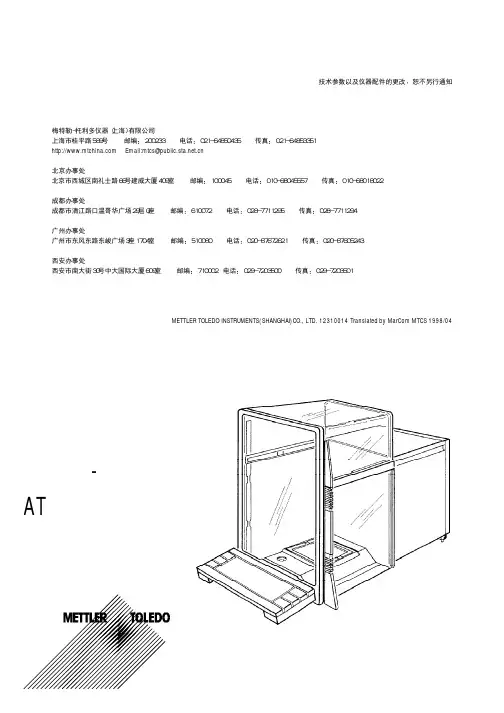
操作指南热重分析仪使用方法说明书一、简介热重分析仪(Thermogravimetric Analyzer,简称TGA)是一种用于研究物质在升温过程中质量变化的实验仪器。
它通过分析物质的失重情况,可以确定物质的热稳定性、化学反应过程以及组成等信息。
本文将介绍热重分析仪的使用方法,以便用户正确操作仪器并获取准确可靠的实验结果。
二、仪器准备1. 环境准备:确保操作环境清洁、干燥、无明显震动。
2. 电源接通:将热重分析仪的电源线连接到电源插座上,并确保电源正常供电。
3. 仪器检查:检查仪器的电源开关、控制按钮和显示屏是否正常运作,确保仪器各部件完好。
三、样品准备1. 样品选择:根据实验要求选择适当的样品,确保样品与试样舟兼容。
2. 样品预处理:根据实验要求进行必要的样品预处理,如干燥、研磨等,并记录样品质量。
3. 样品装填:将样品装填到试样舟中,确保装填的样品质量均匀,并记录样品质量。
四、实验操作1. 试样舟安装:将装有样品的试样舟安装到热重分析仪的样品台上,并确保固定牢固。
2. 实验参数设置:通过控制面板上的按钮或旋钮设置实验参数,如升温速率、升温范围、保持时间等。
根据实验要求选择适当的参数,并确保参数设定无误。
3. 实验启动:按下启动按钮,仪器开始进行升温实验。
在实验过程中,可以实时监测实验数据的变化,并进行必要的记录。
4. 实验结束:当实验达到设定的结束条件时,仪器会自动停止运行。
注意安全操作,等待试样舟冷却后再进行下一步处理。
五、数据分析1. 数据导出:将实验数据导出到电脑或存储设备中,以备后续分析使用。
2. 数据处理:使用相应的数据处理软件对实验数据进行处理和分析,以获得所需的结果和曲线。
3. 结果解读:根据实验数据和曲线,进行结果解读和分析,阐述样品的热稳定性、降解过程、组成变化等信息。
六、仪器维护1. 清洁保养:经过实验使用后,及时清洁仪器表面,注意避免水或化学溶液进入仪器内部。
2. 舟器更换:根据需要定期更换试样舟和舟器,确保准确的实验结果。
热重分析仪操作说明1. 简介1.1 概述本文档旨在提供关于热重分析仪的详细操作指南,以帮助用户正确使用该设备。
1.2 设备描述热重分析仪是一种用于测量样品质量随温度变化而发生的动态性能变化的实验装置。
它通过加热和称量样品来确定其失去或吸收水、挥发物等成份时所需时间及相应质量损失或增加。
2. 安全注意事项在使用热重分析仪之前,请务必阅读并遵守以下安全注意事项:- 使用者需要穿戴适当的个人防护装备,如实验手套、眼镜等;- 遵循厂商提供的相关安全规程,并确保了解紧急停机程序;- 不要将易爆物料放入设备中进行测试;3. 准备工作在开始运行研究之前,请按下列步骤准确设置您想要执行试验:a) 打开主电源按钮;b) 将计算机连接到系统控制台上;4.标定与校正标定过程可以有效地改善热重分析仪的准确性和可靠性。
请按以下步骤进行标定:a) 使用已知质量的样品对设备进行校正;b) 确保温度传感器正确放置并与控制台连接良好。
5.操作流程为了获得最佳结果,请遵循下列操作流程:a)将待测样品精心称取,并记录其初始质量;b)将样品放入试验舱中,关闭舱门;c)设置所需实验参数(如升温速率、测试时间等),“开始”按钮启动实验。
6. 数据处理实施完毕后, 可以通过计算机软件来获取数据及图表.7. 故障排除如果在使用过程中出现任何故障或异常情况,请参考用户手册提供的故障排除指南或联系厂商技术支持人员寻求帮助。
8. 相关附件- 用户手册:包含更详细信息和进一步说明。
- 样本报告模板:用于整理和呈现测试结果9. 法律名词及注释- 责任免责条款: 指明该文档不承担由于误差、失真或其他因素引起损害而产生法律责任的免责声明。
- 保密条款: 指明该文档中包含的信息受到机密性和非公开性约束,并且未经授权不得复制、传播或使用。
热重分析仪操作指南说明书一、引言热重分析仪是一种用于测量材料在升温过程中质量随温度变化的仪器。
该操作指南旨在为用户提供关于热重分析仪的操作步骤和注意事项的详细说明,以确保正确、安全地操作仪器并获取准确的测量结果。
二、仪器概述热重分析仪由样品盘、电炉、电子天平、温度控制系统等组成。
样品盘用于放置待测样品,电炉提供升温功能,电子天平用于实时测量质量变化,温度控制系统控制升温速率和稳定样品温度。
三、操作步骤1. 准备工作a. 确保仪器已正确连接至电源,并处于待机状态。
b. 清洁样品盘和电子天平,确保无残留物。
c. 准备待测样品,注意将样品分为小块以保证准确测量。
2. 启动仪器a. 按下电源开关,热重分析仪将进入启动自检程序。
b. 等待仪器自检完成后,进入主界面。
3. 设置实验参数a. 选择升温速率和温度范围,根据待测样品的特性进行设定。
b. 确定实验试验制度(常压、氮气保护等)。
c. 设置质量损失的判定标准。
4. 样品操作a. 将样品放置于样品盘中心,确保样品分布均匀。
b. 关闭样品盖,保证样品在升温过程中不外溢。
c. 确保样品盘与电子天平连接稳固。
5. 开始实验a. 点击开始按钮,热重分析仪将自动开始升温,并实时记录质量变化。
b. 观察实验结果,确保质量曲线变化平稳,无异常情况。
6. 实验结束a. 实验完成后,将热重分析仪恢复到待机状态。
b. 关闭电源开关,断开电源。
四、注意事项1. 使用和操作热重分析仪时,应穿戴防护手套和实验服,避免意外伤害。
2. 清洁仪器部件应使用干净的纯水或适当的溶剂,切勿使用腐蚀性或有害化学物质。
3. 在操作过程中注意热重分析仪的温度,避免烫伤。
4. 实验前应熟悉待测样品的性质,并根据需要进行样品预处理。
5. 实验过程中,观察样品质量曲线,及时处理仪器故障或异常情况。
五、故障排除1. 若出现仪器无法启动或显示异常的情况,应检查电源接口和电源线是否接触良好。
2. 若样品质量曲线不稳定或出现明显的异常变化,可能是样品配制不当或仪器故障导致,应排除异常原因。
请确保仪器工作环境
放在室内稳定工作台上水平
具有足够距离(> 15cm)
照明充足
强烈气流温度波动
电子天平使用注意事项良好的称量管理规范
1. 准备操作
2. 注意事项
调节水平
在使用前,必须查看水平指示器中的气泡是否在黑圈内。
如气泡不在黑圈内,请利用水平调节脚将气泡调至黑圈中央位置。
此时,天平就处于完全水平状态。
预热天平
处于断电状态的天平,在说明书所指定的使用环境状况小时;分析天平2 天平应放置于具有防磁表面的稳定工作台上,应避免震动、气流及阳光的照射。
天平是精密仪器,使用时动作要轻缓。
称量时,请勿按压工作台。
3. 更多天平知识
除了基础称量,天平还有密度称量、配方称量等许多
其他应用。
关于应用的详细介绍,请查阅具体型号的说明书。
获取更多最新的天平信息,敬请访问我们的网站:
请勿用手或样品冲击秤盘,尽量避免将超出量程范围的样品放置在秤盘上,以降低不慎操作损坏天平的可能性。